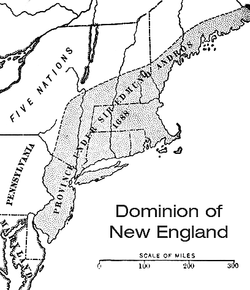New England Dominion
The Dominion of New England in America (1686–89) was an administrative union of English colonies covering New England and the Mid-Atlantic Colonies (except for the Colony of Pennsylvania). Its political structure represented centralized control similar to the model used by the Spanish monarchy through the Viceroyalty of New Spain. The dominion was unacceptable to most colonists because they deeply resented being stripped of their rights and having their colonial charters revoked. Governor Sir Edmund Andros tried to make legal and structural changes, but most of these were undone and the Dominion was overthrown as soon as word was received that King James had left the throne in England. One notable change was the introduction of the Church of England into Massachusetts, whose Puritan leaders had previously refused to allow it any sort of foothold.
The Dominion encompassed a very large area from the Delaware River in the south to Penobscot Bay in the north, composed of New Hampshire, Massachusetts, Rhode Island, Connecticut, New York, and New Jersey, plus a small portion of Maine. It was too large for a single governor to manage. Governor Andros was highly unpopular, and was seen as a threat by most political factions. News of the Glorious Revolution in England reached Boston in 1689, and the Puritans launched a revolt against Andros, arresting him and his officers.
...
Wikipedia


